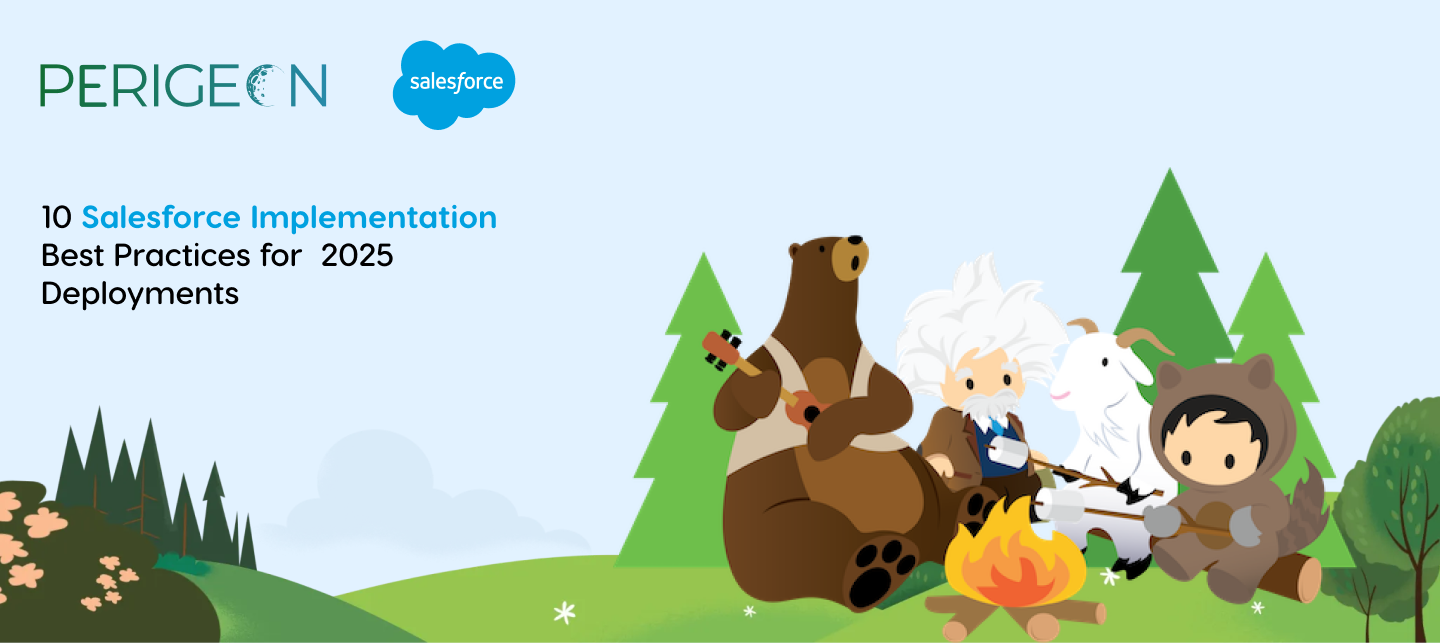The Salesforce implementation landscape has transformed dramatically, marking 2025 as a pivotal year for AI-driven CRM deployments. Organizations now face a new reality where success depends on seamlessly integrating three core components:
- Advanced AI Technologies – Including autonomous agents and generative AI
- Data Cloud Architecture – Enabling unified customer data management
- Intelligent Automation – Streamlining complex business processes
The platform’s evolution brings powerful capabilities through Agentforce, Salesforce’s autonomous-agent layer that revolutionizes how businesses handle customer interactions and backend operations. This AI-native approach demands a fresh perspective on implementation strategies.
Today’s successful Salesforce deployments require careful orchestration of:
- Real-time data processing
- AI prompt management
- Cross-channel automation
- Human-bot collaboration
- Security governance
The stakes are high – organizations implementing Salesforce in 2025 must navigate weekly AI skill updates, quarterly platform releases, and rapidly evolving customer expectations. A structured yet adaptable implementation approach becomes essential for maximizing ROI and maintaining competitive advantage.
This guide explores 10 proven best practices for Salesforce implementations in the AI-driven era. These strategies will help you build a robust foundation for your CRM deployment while leveraging the latest platform innovations to drive business growth.
1. Align Stakeholders and Define Clear ObjectivesSuccessful Salesforce implementations start with strong stakeholder alignment.
Your project needs active participation from:
- Executive Leadership: Driving strategic vision and resource allocation
- Department Heads: Providing operational insights and team requirements
- End Users: Sharing daily workflow needs and pain points
- IT Teams: Managing technical infrastructure and integration points
Create a structured governance framework that defines roles, responsibilities, and decision-making processes. Your CRM goals should directly map to specific business outcomes:
- Revenue growth targets
- Customer satisfaction metrics
- Operational efficiency improvements
- Cost reduction objectives
Track implementation success through quantifiable metrics:
- User adoption rates (aim for >80%)
- Process automation efficiency (measured in time saved)
- Data quality scores (>95% accuracy)
- ROI measurements (revenue impact, cost savings)
Set up regular stakeholder check-ins to review progress against these metrics. Use Salesforce’s native reporting capabilities to create real-time dashboards that showcase key performance indicators and implementation milestones.
2. Capture and Prioritize Requirements Through an Agent-Centric Lens
The 2025 Salesforce implementation landscape demands a shift from traditional requirement gathering to an agent-centric approach. Agentforce’s autonomous layer transforms how you capture and structure workflow requirements.
Key Requirements Focus Areas:
Key Requirements Focus Areas:
- Agent Capability Mapping
- Map business processes to Agentforce’s AI-driven capabilities
- Identify tasks suitable for autonomous handling
- Document human-agent interaction points
- Business Impact Assessment
- Rank features based on ROI potential
- Evaluate automation opportunities against manual processes
- Measure potential time savings and error reduction
- Low-Code Translation Strategy
- Break down complex requirements into modular components
- Create visual process flows using drag-and-drop builders
- Design reusable automation templates
You’ll need to document specific use cases where Agentforce can take over repetitive tasks. For example, auto-categorizing incoming customer requests, routing cases based on AI analysis, or generating preliminary response drafts.
The requirement gathering process should include AI prompt templates, data validation rules, and workflow triggers that align with your business logic. This structured approach ensures your implementation leverages Agentforce’s full potential while maintaining operational efficiency.
3. Build on a Strong Data Cloud Foundation
Data Cloud is essential for successful Salesforce implementations in 2025. Your data architecture must support AI operations while keeping data intact and accessible across all platform features.
Key Components of Data Cloud Implementation:
Unified Customer Profiles
- Create comprehensive customer views by connecting data from various sources
- Implement real-time data synchronization
- Set up automated data cleansing processes
AI-Ready Data Models
- Structure data to support natural language processing
- Design schemas compatible with Agentforce’s learning algorithms
- Build relationships between objects that enable predictive analytics
Scalable Architecture Elements
- Deploy microservices-based data integration patterns
- Implement flexible storage solutions for increasing data volumes
- Use API-first design principles for smooth system connectivity
Your Data Cloud foundation requires careful attention to linkage rules. Set up identity resolution mechanisms to merge duplicate records automatically. Create data validation rules that maintain high data quality standards while allowing AI systems to adapt to new patterns.
Configure your data models with built-in flexibility to accommodate future AI capabilities. This includes implementing hierarchical data structures and establishing clear parent-child relationships between objects.
4. Use DevOps-Controlled Versioning for AI Prompts and Automation Logic
DevOps-controlled versioning creates a secure foundation for managing AI prompts and automation logic in Salesforce implementations. Your team needs a robust version control system to track changes, maintain security, and ensure smooth deployments.
Key Version Control Components:
- Git repositories for storing AI prompt templates
- Automated testing environments for prompt validation
- Secure credential management for API access
- Continuous integration pipelines for prompt deployment
The DevOps pipeline safeguards prompt integrity through:
- Automated syntax validation
- Security compliance checks
- Performance impact assessment
- Rollback capabilities
Agentforce skill updates require automated deployment processes to handle frequent changes. You can implement:
- Scheduled deployment windows
- Automated conflict detection
- Real-time monitoring of deployment status
- Impact analysis on existing workflows
Your DevOps strategy should include branching policies for different environments:
- Development branches for testing new prompts
- Staging environments for validation
- Production-ready branches for approved changes
This systematic approach ensures reliable prompt management while maintaining security and performance across your Salesforce implementation.
5. Include Human Approval Checkpoints for Sensitive Tasks
Human oversight is still important in AI-driven Salesforce implementations. You need strategic approval checkpoints for sensitive operations like:
- High-value transactions exceeding preset thresholds
- Customer data modifications
- Contract amendments
- Regulatory compliance validations
Design Effective Approval Gates:
- Set up multi-level approval hierarchies based on task sensitivity
- Create automated notifications for pending approvals
- Implement parallel approval paths for time-critical processes
- Configure fallback approvers to prevent workflow bottlenecks
Speed-Optimized Human Checkpoints:
- Use AI-powered pre-screening to filter routine cases
- Enable batch approvals for similar items
- Integrate mobile approval capabilities
- Set up auto-approval rules for low-risk scenarios
The key is to find a balance between security and efficiency. You can do this by using smart routing rules that send only complex cases to human reviewers while allowing simple tasks to be processed automatically. This way, you maintain control without causing unnecessary delays in your Salesforce workflows.
6. Use a Hybrid Approach That Combines Agile and Waterfall Methods
Modern Salesforce implementations can be complex, requiring a more flexible approach to project management. The hybrid method combines the structured planning of Waterfall with the adaptability of Agile to achieve the best results.
Waterfall Components:
- Initial requirements gathering and documentation
- Core infrastructure setup and data modeling
- Security framework implementation
- Budget allocation and resource planning
Agile Development Cycles:
- AI skill development and refinement
- Integration testing and deployment
- User interface customizations
- Automation workflow iterations
The hybrid approach allows teams to maintain stability while adapting to changing requirements. Fixed-scope elements benefit from Waterfall’s sequential phases, ensuring thorough documentation and clear milestones. Agile sprints handle dynamic components like AI capabilities and user feedback integration, enabling rapid adjustments and continuous improvement.
Key Benefits:
- Predictable timelines for core infrastructure
- Flexible response to emerging AI capabilities
- Reduced risk through incremental delivery
- Enhanced stakeholder visibility and engagement
- Balanced control and adaptability
Teams can organize two-week sprints for AI development while following traditional Waterfall phases for foundational elements. This structure creates a robust framework that supports both planned deliverables and innovative feature development.
7. Conduct Rigorous Testing Including Scripted User Acceptance Testing (UAT)
Testing Salesforce implementations requires a methodical approach to ensure that the system works correctly for different users. Your test plan should reflect how
your business actually operates, covering areas such as:
- Validating data migration
- Checking integration points
- Verifying AI-driven workflows
- Ensuring security permissions are in place
- Testing custom configurations
Scripted UAT is essential for maintaining quality. Create detailed test scripts that:
- Outline each user action step-by-step
- Specify the expected results
- Record the actual outcomes
- Highlight any discrepancies that need fixing
To optimize performance, it’s important to continuously monitor and make adjustments:
- Conduct load tests to evaluate how quickly the system responds
- Measure the time it takes for AI prompts to respond
- Check how fast Data Cloud synchronization occurs
- Assess the execution speed of automation workflows
Your testing strategy should include using sandbox environments to replicate production conditions. Set up specific testing instances for:
- Development testing
- Integration testing
- User acceptance testing
- Performance testing
By regularly conducting testing cycles, you can identify and fix issues early on, which will minimize problems after deployment and ensure a smooth transition for users.
8. Plan Comprehensive Change Management Involving Humans and Bots
Change management in 2025 Salesforce deployments requires a dual-focused approach addressing both human users and AI agents. Your organization needs a structured plan that considers the unique interactions between these two groups.
Training Programs for AI-Driven Workflows:
- Role-specific training modules focusing on AI collaboration
- Hands-on practice sessions with Agentforce interactions
- Customized learning paths based on user comfort with AI tools
Bot-Human Collaboration Framework:
- Clear documentation of autonomous agent capabilities
- Defined handoff points between bots and human users
- Established protocols for AI assistance and human override
Effective Communication Strategy:
- Regular updates through multiple channels (Slack, email, team meetings)
- Visual guides showing AI-human workflow interactions
- Success stories highlighting positive impact of new implementations
Change Champions Network:
- Designated team members across departments
- Early access to new features for testing and feedback
- Regular check-ins to address adoption challenges
Your change management plan should include metrics tracking both human adoption rates and bot performance statistics. This data helps identify areas needing additional support or optimization in your AI-driven CRM environment.
9. Partner with Experienced Salesforce Consultants for Secure & Scalable Deployments
The complexity of AI-native Salesforce features demands expert guidance for successful implementation. Certified Salesforce consulting partners bring specialized knowledge in:
- AI Integration & Security
- Data Cloud architecture optimization
- Secure AI prompt management
- Compliance framework implementation
- Managed Services
- 24/7 platform monitoring
- Performance optimization
- Regular security audits
- Automated backup systems
Specialized builds like Commerce Cloud and CPQ require deep technical expertise. Professional consultants deliver:
- Custom solution architecture
- Industry-specific configurations
- Integration with legacy systems
- Performance testing
- Security hardening
Staff augmentation services provide flexible access to specialized talent:
- Certified Salesforce developers
- AI/ML specialists
- Data architects
- Security experts
- Business analysts
Leading consulting partners maintain dedicated teams trained in the latest Salesforce releases, ensuring your implementation stays current with platform innovations while maintaining enterprise-grade security standards.
10. Embrace Continuous Improvement Post-Go-Live with Ongoing Training & Feedback Loops
Salesforce implementation success extends beyond the initial deployment. A dynamic approach to post-go-live management creates sustainable value through:
Regular Training Initiatives
- Structured Trailhead learning paths customized for different user roles
- Hands-on workshops focused on new AI-native features
- Weekly micro-learning sessions covering Agentforce skill updates
- Peer-to-peer knowledge sharing through internal champions
Feedback Collection Systems
- In-app surveys capturing real-time user experience data
- Monthly stakeholder interviews to identify pain points
- Analytics-driven insights on workflow adoption rates
- AI-powered sentiment analysis of user interactions
Continuous Refinement Strategy
- Bi-weekly sprints to implement user-requested enhancements
- Regular assessment of automation effectiveness
- Performance monitoring through Data Cloud metrics
- Adjustment of AI prompts based on usage patterns
This iterative improvement cycle keeps your Salesforce instance aligned with evolving business requirements while maintaining high user adoption rates. Companies that invest in continuous learning see 32% higher ROI from their Salesforce implementation compared to those following a static approach. Furthermore, adopting a continuous improvement strategy not only enhances user experience but also significantly boosts overall operational efficiency.
Conclusion
A successful Salesforce deployment in 2025 requires a delicate balance between structured methodology and adaptable execution. The ten best practices outlined in this guide serve as your roadmap to maximize the platform’s potential in an AI-driven era.
Your implementation journey demands:
- Strategic Vision: Align stakeholders, define clear objectives, and build on a robust Data Cloud foundation
- Technical Excellence: Implement DevOps-controlled versioning, conduct thorough testing, and partner with experienced consultants
- Human-Centric Approach: Balance autonomous operations with manual oversight, manage change effectively, and maintain continuous learning
The future of CRM lies in your ability to harness AI capabilities while maintaining human touchpoints. Organizations that embrace these implementation best practices position themselves to:
- Drive higher user adoption rates
- Accelerate time-to-value
- Create scalable, future-ready solutions
- Deliver exceptional customer experiences
Remember: Your Salesforce implementation isn’t a one-time project—it’s an evolving journey. By following these guidelines and maintaining a commitment to continuous improvement, you’ll build a dynamic CRM ecosystem that grows with your business needs.
Start implementing these practices today to unlock the full potential of your Salesforce investment and stay ahead in the rapidly evolving digital landscape of 2025 and beyond.







